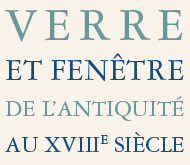5. Conclusions
All window glass samples in the analysed set were of the calco-potassic type. No lead glass or soda glass panes were found in this group, although their presence are sometimes reported in stained-glass windows. Most of the window glass is of the HLLA-type. Glass with a potash composition occurs frequently as substrate glass in 12-15th century stained-glass windows, although a limited number of similar fragments was also found in windows originating from secular buildings.
Based on the observed window glass compositions, three periods can be distinguished: (a) the period before the 15th century, (b) the 15-17th century period, and (c) the 18th century. An abrupt change in composition was observed at the end of the 14th century. For the HLLA glass, the amount of SiO2 among the various subgroups increased while the K2O:CaO ratio decreased from about 1:3 to around 1:4. Additionally, sometimes NaCl was introduced in the batch as a separate component. Since an inverse relation between the K2O concentration and the amount of NaCl added can be observed, apparently the total contribution of flux material (ash + sea salt) to the batch was kept constant during the production.
For potash glass, the sudden increase in SiO2-abundance at the end of the 14th century is the most remarkable change. The limited number of 18th century samples might suggest a sudden change in chemical composition. The amount of SiO2 was higher than before, the amount of P2O5 was low which indicated that only the soluble part of wood ash was employed as raw material, and it contained more K2O than CaO.
Acknowledgements
The authors would like to thank all persons who participated directly or indirectly in the sampling campaign and in particular Joost Caen (stained windows), Silvia Mathieu (Namur samples) and Johan Veeckman (Antwerp samples). Additionally we would like to thanks J. Kunicki-Goldfinger for carefully reading and formulating comments about the manuscript.

